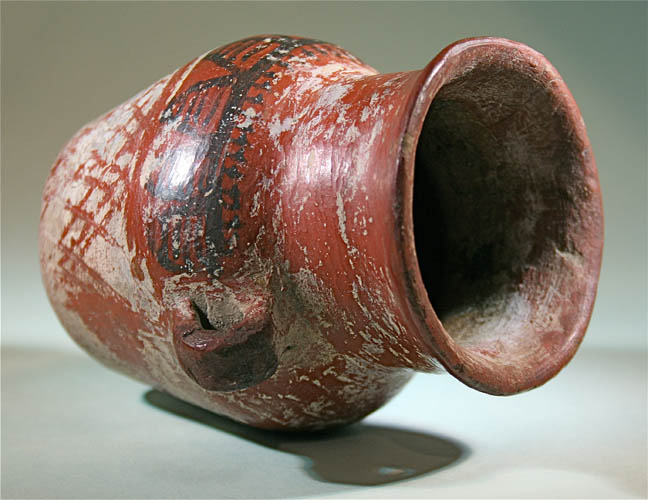

Title: American Indian Hand-Made Red Clay Pot
Shipping: $30.00
Artist: N/A
Period: 10th Century
History: N/A
Origin: North America > United States
Condition: Museum Quality
Item Date: 1500 to 400 years old
Item ID: 1457
The art of creating beautiful ceramics has been cultivated for centuries in American Indian Culture. Simply by looking at the magnificent ceramics created by pre-Columbian civilizations, we can see that this art possesses an extraordinary artistic heritage. Indian Artists have drawn upon this legacy and re-invented ancestral techniques, such as the coil method used in pottery. Molded from brown or red-gray clay with multi-colored glaze, this piece has wonderful wear and lines. This artifact is "Museum Quality." We think it could date back as far back as 400 years - or even 1500 years.
Link: http://en.wikipedia.org/wiki/Native_American_pottery
Prior to the coming of Europeans, the people of both the North and South American continents had a wide variety of pottery traditions. However, there is no evidence that a Native American pottery ever invented the pottery wheel. Because of this, all known Pre-Columbian American pottery was made entirely by hand, using a number of traditional techniques. These include sculptural modeling, press molding, coiling, and paddling. Functional pottery objects were produced by many cultures, as were figurines, masks, and ritual items. The procedure for creating coil pottery favored in the Eastern United States was more focused on preparing clay than in the West. The women would spend hours on end mixing the clay they had gathered with crushed seashells, sand, plant materials and other temper until they had precisely the right consistency; then wedging it to remove the air pockets and humidity that could easily make it blow up during firing. They would then pound out a flat circle of clay to serve as a base. While the potter was building the coils up, she was also deliberate to take the time to blend them together. Once they were blended nicely, there was no trace of the ropes of clay so carefully entwined to form the pot, no deviation in the thickness of the walls, and therefore no weaknesses. As a finishing touch, the pot was struck with a cord-wrapped stick to compact it and give it its final shape. American Indians have never used enclosed kilns, so the pot was put in a shallow pit dug into the earth along with other unfired pottery, covered with wood and brush, and lit on fire where it would harden and heat to temperatures of 1400 degrees or more. For a finishing touch, the surface of the pot would be rubbed vigorously with special stones, leaving the surface smooth and polished.